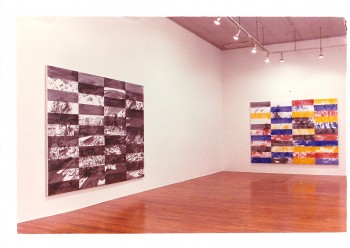Thompson, Walter, “Roy Fowler at Anne Plumb”, Art in America, September 1990

ARTS magazine September 1990
Roy Fowler at Anne Plumb.
The system of Fowler's new paintings seems almost absurdly simple: loose, free renderings of a Baroque-style landscape—like the sepia-wash drawings of Rubens—overlaid by a transparent screen of grids which impose their various hues (red, blue, yellow, gray, white) on the landscape. But if the system is simple, the effect is not. Perceptually, these are complicated works, their complexity deriving from the way the two' schemes are adjusted to each other and the peculiar tension thus generated. The landscape contributes the overall figuration that we feel compelled to search out and experience as a coherent unity; the grid interrupts and confounds our intention. The grid is a barrier that prevents us from entering fully or comfortably into the mythic world of the drawing. It is a staccato intrusion that repeatedly reminds us of the artificiality of the illusion. But the grid should not be defined only in negative terms, as if it were there for the sole purpose of impairing our view of the landscape. The grid divides the canvas into discrete units, each forming a zone of focus. In a conventional act of seeing, we peruse an object or a horizon by a series of glances, and our sense of the whole is a reconstitution from these separate acts. Fowler inscribes upon his painted scene a regularized set of sections that may be viewed, in a metaphorical sense, as a pre-determined re-creation of the process by which we take in a scene. He forces us to become conscious of an act that is usually unconscious. His segmentation is made more emphatic by staggered colors. Strong hues isolate the parts of the landscape, often giving each part an emphasis and an identity that separates it from the whole. One struggles constantly to maintain the unity of the landscape, in opposition to the individualized parts that continually jump out as an effect of color. In sum, the two systems, so clear in their identities as landscape and grid, mesh to make a third, hybrid reality that transforms both. —Walter Thompson